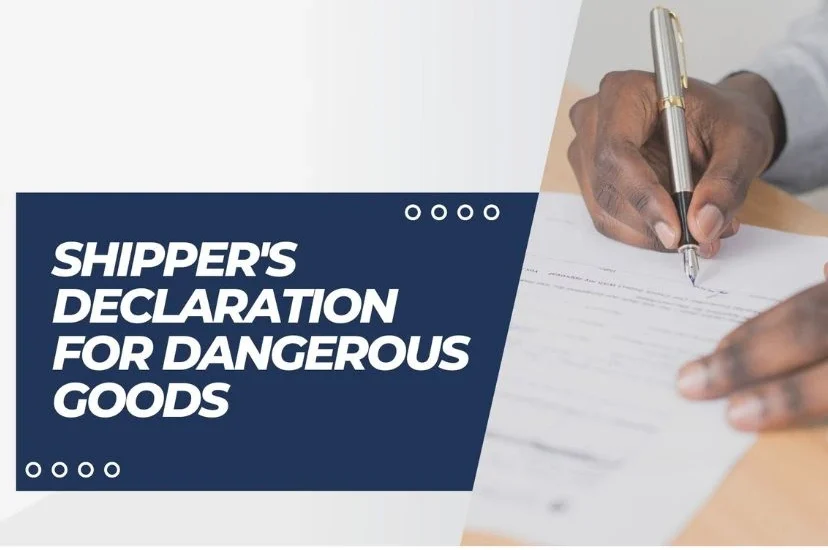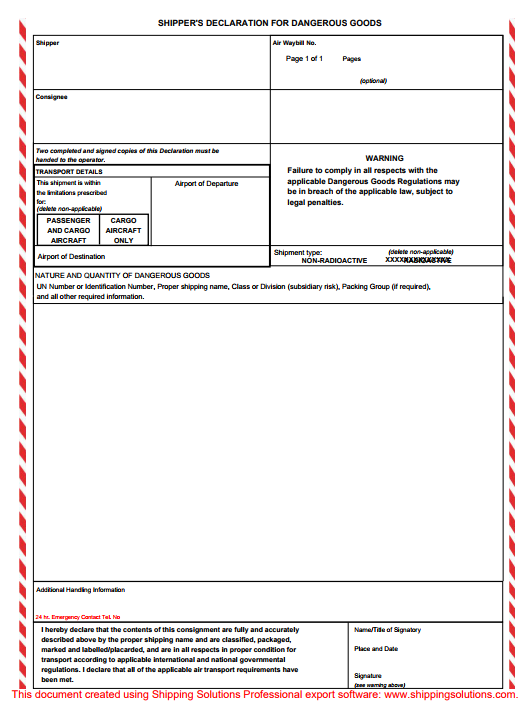- December 31, 2024
- Posted by: admin
- Categories: Export Financing, Blog

The transportation of dangerous goods is a complex process that demands careful handling and precise documentation. Among these documents, the Shipper’s Declaration for Dangerous Goods (DGD) stands out as one of the most critical. This document plays a vital role in ensuring that hazardous items are shipped, handled, and transported safely across air, sea, and land.
In this guide, we’ll delve into the details of a shipper’s declaration, why it’s essential, and how to complete it accurately. We’ll also discuss key regulations and offer practical tips for safe shipping.
What Is a Shipper’s Declaration for Dangerous Goods?
The Shipper’s Declaration for Dangerous Goods is an official document provided by the shipper to declare that the shipment contains hazardous materials. Its purpose is to inform all relevant parties—such as airlines, ground handlers, and freight forwarders—about the nature of the goods and how to handle them properly.
The declaration serves as a safeguard against potential accidents and ensures compliance with international laws and regulations related to hazardous materials. The document includes critical information, such as:
- The type of hazardous material.
- Packaging instructions.
- Quantity and classification of the goods.
Why Is a Shipper’s Declaration Important?
When transporting dangerous goods, safety is paramount. Mishandling hazardous materials can lead to severe consequences, including environmental damage, injuries, or even loss of life. The declaration ensures:
- Safe Handling: Clear instructions on how to load, unload, and transport the goods prevent accidents.
- Compliance: It demonstrates adherence to international and national regulations, avoiding legal penalties.
- Transparency: It informs all stakeholders about the risks and precautions associated with the shipment.
Without this document, dangerous goods cannot be legally transported.
What Items Require a Shipper’s Declaration?
Any substance or item classified as dangerous requires a shipper’s declaration. The International Air Transport Association (IATA) and International Maritime Organization (IMO) provide detailed guidelines on what qualifies as dangerous goods. Broadly, these items fall into nine categories:
- Explosives: Items like fireworks, flares, or seatbelt pretensioners.
- Gases: Includes flammable, toxic, and non-flammable gases like oxygen cylinders or aerosol sprays.
- Flammable Liquids: Common examples are nail polish, alcohol, and certain types of paint.
- Flammable Solids: Substances that ignite easily, such as matches or phosphorus.
- Oxidizing Substances: Includes items like fertilizers or organic peroxides.
- Toxic and Infectious Substances: Examples include pesticides, medical samples, or blood tests.
- Radioactive Materials: Used in medical isotopes and smoke detectors.
- Corrosive Substances: Includes items like bleach and drain cleaners.
- Miscellaneous Dangerous Goods: Lithium batteries, dry ice, and magnets fall into this category.
Each of these categories comes with specific handling and packaging requirements to ensure safety.
Key Information Included in a Shipper’s Declaration
The Shipper’s Declaration for Dangerous Goods must provide comprehensive details about the shipment. These details include:

- UN Number: A unique identifier assigned to hazardous materials for classification.
- Proper Shipping Name: The official name of the substance as per regulations.
- Class or Division: Specifies the hazard type (e.g., flammable liquid, toxic substance).
- Packing Group: Indicates the level of hazard (I – high risk, II – medium risk, III – low risk).
- Net Quantity: The weight or volume of the dangerous goods.
- Type of Packaging: Describes how the goods are packed, such as fiberboard boxes or plastic containers.
- Emergency Contact Information: Includes the shipper’s contact details for emergencies.
- Consignor and Consignee Information: The full name, address, and contact details of the sender and receiver.
Providing accurate information is crucial to avoid delays, fines, or safety risks.
Who Can Sign a Shipper’s Declaration?
The declaration must be signed by the shipper or consignor—the person or entity responsible for shipping the goods. This signature confirms that:
- The shipment complies with applicable regulations.
- The information provided is accurate.
In cases where the declaration is transmitted electronically via platforms like Electronic Data Interchange (EDI) or Electronic Data Processing (EDP), the shipper’s name in capital letters may replace the signature.
It’s important to note that only individuals trained in US DOT hazardous materials regulations are qualified to sign this document.
Regulations Governing Dangerous Goods Declarations
The rules for dangerous goods vary depending on the mode of transport:
Air Transport:
- Governed by the IATA Dangerous Goods Regulations (DGR).
- The DGD is mandatory for air shipments, ensuring compliance with strict safety standards.
Sea Transport:
- Regulated by the International Maritime Dangerous Goods (IMDG) Code.
- Additional documents, like the Material Safety Data Sheet (MSDS), may be required.
Road and Rail Transport:
- Must follow guidelines outlined in the IMDG Code and DGR.
How to Fill a Shipper’s Declaration for Dangerous Goods?
Filling out the DGD can seem daunting, but following a structured approach simplifies the process. Here’s how to complete the key sections:
- Shipper Details: Include your full name, address, and contact number.
- Consignee Details: Provide the recipient’s complete information, including name, address, and phone number.
- Air Waybill Number: Enter the number provided by the airline handling the shipment.
- Transport Details: Specify whether the goods are being transported by cargo-only aircraft or both passenger and cargo aircraft.
- UN Number: Add the unique four-digit UN number assigned to the hazardous material.
- Proper Shipping Name: Use the official name of the material as per the IATA or IMDG guidelines.
- Class and Packing Group: Identify the hazard class (e.g., flammable liquid) and the packing group (I, II, or III).
- Quantity and Packaging: Mention the net quantity of the goods and describe the type of packaging used.
- Emergency Contact Information: Provide a reliable phone number for emergencies.
Example of a Filled Shipper’s Declaration
Here’s a sample filled-out DGD for reference:
- Shipper: John Carter, SafeChem Co., 123 Green Street, NY, USA.
- Consignee: Ryan Kennedy, PharmaCare Inc., Sydney, Australia.
- Air Waybill Number: 987654321.
- Transport Details: Cargo Aircraft Only.
- UN Number: UN 1993.
- Proper Shipping Name: Flammable Liquid (Ethanol).
- Class: 3.
- Packing Group: II.
- Quantity: 10 liters in two fiberboard boxes.
Digital Advancements in Dangerous Goods Declarations
Modern technology has streamlined the process of declaring dangerous goods. The introduction of e-DGD (electronic Dangerous Goods Declaration) systems allows shippers to submit declarations digitally. Benefits include:
- Reduced Errors: Automated checks minimize mistakes.
- Increased Transparency: Stakeholders can access real-time data.
- Improved Efficiency: Speeds up the shipping process.
FAQs on Dangerous Goods Declarations
1. Is a DGD required for all hazardous shipments?
Yes, except for certain accepted quantities specified in IATA and IMDG guidelines.
2. What happens if I don’t submit a DGD?
Shipping hazardous goods without a declaration is illegal and can result in fines or shipment rejection.
3. Can handwritten forms be used?
Check with your courier service, as some require typed forms.
4. Are there exceptions for small quantities?
Yes, some goods under specified quantity limits may not require a DGD.
5. Who is responsible for filling the form?
The shipper or consignor is solely responsible for completing and signing the declaration.
Conclusion
The Shipper’s Declaration for Dangerous Goods is more than just a piece of paperwork—it’s a critical component of safe and lawful shipping. By understanding the requirements, providing accurate information, and adhering to regulations, shippers can ensure smooth transportation of hazardous goods while minimizing risks. Whether using traditional forms or embracing digital solutions like e-DGD, the key lies in precision, compliance, and transparency.
Also Read: The Essential Guide to Export Logistics for Businesses